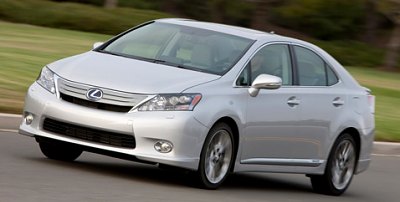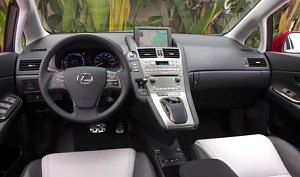Lexus HS250h (Toyota Sai)
Debut: 2009 |
||||||
The marketing people of Lexus told us HS250h is the division's first dedicated hybrid car, something like the Prius of Lexus. It sounds cool, doesn't it ? Well, depend on how you see it. If you are an existing owner of Prius, you may be excited with this idea and set your sight on it as your next upgrade. The green messages it bring is stronger than the existing "performance hybrids" of Lexus, i.e. GS450h, RX450h and LS600h. These cars are cleaner than conventional cars, of course, but their hybrid powertrains bias towards the performance side, with intention to lift V6 and V8 into the league of V8 and V12 respectively. HS250h is different. From the engine performance index in its name you can easily see it has no sporting pretension at all. All it wants to do is to save fuel... at least this is what Lexus wants you to believe. However, green image aside, this car is quite pointless. First of all, we have to question its positioning in Lexus' model tree - where does it fit in relation to IS and ES ? Size-wise, it falls into the same segment as IS and ES. Performance-wise, it is much weaker than both. Price-wise, it slips between IS250 and IS350, and about the same as ES350. It makes an already embarrassing situation even more embarrassing. I can imagine many Lexus salesmen will simplify the choices in this way: "If you want handling, this one. If you want refinement, that one. If you want green, HS250h will be the one !" However, in reality customers always ask for the best combination of all essential aspects. It will be more difficult to explain then.
It could be even more embarrassing if you know where its ingredients come from. The front-wheel drive floorpan of HS250h combines that of Prius and Avensis (in particular double-wishbone rear suspensions), which is hardly what you expect for a premium car. The hybrid powertrain is carried over intact from Camry Hybrid. This means a 2.4-liter Atkinson-cycle four-cylinder engine mated with an electric motor and planetary-gear CVT. Combined output is only 187 horsepower. In addition to the 1700 kg kerb weight, 0-60 mph acceleration is done leisurely in 8.4 seconds. Again this is not what you would expect on a car at this price. This hybrid powertrain is refined by the standards of Toyota, but not Lexus. Those expecting six-cylinder smoothness from the combination of a four-banger - even with twin-balancer shafts installed - and electric motor will be disappointed. The CVT also tends to keep the engine revving intrusively noisy. This is not helped by the questionable sound insulation of its cabin. Both engine noise and road noise are more obvious than in other Lexuses. Moreover, it does not insulate the sound of regenerative braking and engine on/off as well as it should. "If you want an unrefined Lexus, this will be the one !" What meets our expectation - or the lack of it - is the car's ride and handling. It drives like a Camry with a lot of luggages at the back (think of that NiMH battery pack in the boot). There is little agility or fun to speak of. Predictably, the electrical power steering is muted, and the chassis can be easily pushed into understeer. Even with 18-inch wheels and 225/45 tires fitted, the HS250h is not going to trouble a Ford Mondeo, let alone its more logical rival BMW 3-series and Mercedes C-class.
It lacks a high-quality packaging to compete with those premium rivals too. Lexus has obviously invented a new design theme called L-fatness for the car, which is about as inspiring as Camry. Open the doors, you will see a large piece of hard and gray plastic, tasteless faux alloy or wood accents and a protruding center console that looks as if lifted from a Japanese MPV. Is it really a Lexus? To save the game, HS250h offers a wide range of advanced safety features - but not for free. The additional costs of hybrid powertrain means it will never be renowned for value for money. What HS250h promotes most is greenness, of course. It claims 30 percent of its interior plastics is made of plant-derived bioplastics, which should help reducing CO2 a bit. Apart from the hybrid powertrain, it seeks lower fuel consumption by reducing drag (Cd 0.27). Other fuel saving measures include infrared-reducing windscreen (which saves air conditioning), LED headlamps and exhaust heat recovery system (which quickens engine warm up). Overall, the car achieves an EPA consumption of 35 mpg city and 34 mpg highway. This compare favourably with IS250's 21 mpg and 29 mpg respectively. Nevertheless, compared with other frugal cars it becomes rather ordinary. For example, it can't match Ford Fusion Hybrid's 41 / 36 mpg, let alone the 51 / 48 mpg of Prius. Some European premium diesel cars, such as BMW 320d and Mercedes C220CDI BlueEfficiency, offer better mileage and CO2 emission yet stronger performance. Unlike the HS, they deliver these merits without compromising dynamics and refinement or showing a de-content image. From this view, HS250h is rather pointless. |
||||||
| The above report was last updated on 4 Jul 2009. All Rights Reserved. |





